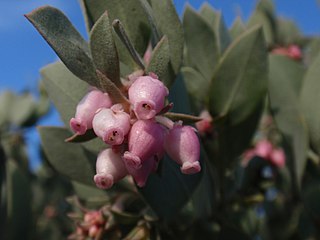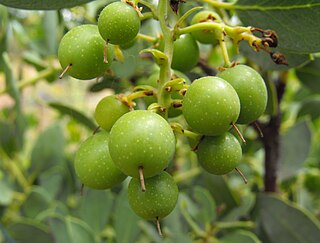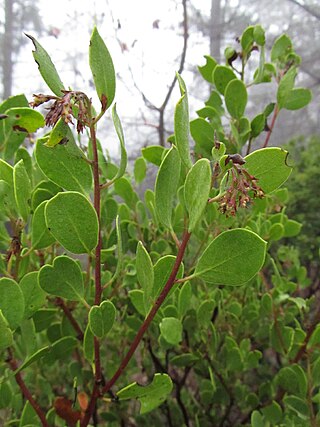
Arctostaphylos catalinae, known by the common name Santa Catalina Island manzanita, is a species of manzanita native to Southern California.

Arctostaphylos glandulosa, with the common name Eastwood's manzanita, is a species of manzanita.

Arctostaphylos bakeri is a species of manzanita known by the common name Baker's manzanita. It is endemic to Sonoma County, California, where it grows in the chaparral and woodlands of the North Coast Ranges. It is sometimes a member of the serpentine soils flora.

Arctostaphylos canescens, common name hoary manzanita, is a species of manzanita.

Arctostaphylos densiflora, known by the common name Vine Hill manzanita, is a very rare species of manzanita. It is endemic to Sonoma County, California, where it is known from only one extant population of 20 to 30 individual plants. These last wild members of the species are on land near Sebastopol which is owned and protected by the California Native Plant Society. In addition, there are five to ten plants of this manzanita taxon growing on private property about a mile away. The local habitat is mostly chaparral on sandy shale soils.

Arctostaphylos hispidula is a species of manzanita known by the common names Gasquet manzanita and Howell's manzanita. It is native to the coastal mountain ranges of southern Oregon and northern California, where it is an uncommon member of the serpentine soils flora and other mountain plant communities. This is a spreading or erect shrub reaching a maximum height between one and two meters. The twigs and foliage are bristly and glandular, the dark green leaves oval to broadly lance-shaped and up to 3 centimeters long. The shrub blooms in crowded inflorescences of urn-shaped flowers and produces whitish to tan colored drupes each 5 to 7 millimeters wide.

Arctostaphylos imbricata is a species of manzanita known by the common name San Bruno Mountain manzanita.

Arctostaphylos luciana is a species of manzanita known by the common name Santa Lucia manzanita, is endemic to California.

Arctostaphylos mewukka is a species of manzanita known by the common name Indian manzanita.

Arctostaphylos montaraensis, known by the common name Montara manzanita, is a species of manzanita in the family Ericaceae.

Arctostaphylos obispoensis is a species of manzanita, known by the common names bishop manzanita and serpentine manzanita, endemic to California.

Arctostaphylos pilosula is a species of manzanita, known by the common names La Panza manzanita and Santa Margarita manzanita, that is endemic to California.

Arctostaphylos purissima is a species of manzanita known by the common name La Purisima manzanita.

Arctostaphylos regismontana is a species of manzanita known by the common name Kings Mountain manzanita. It is endemic to California, where it is known from the northern slopes of the Santa Cruz Mountains in the southern San Francisco Bay Area.

Arctostaphylos silvicola is a species of manzanita known by the common names Bonny Doon or silverleaf manzanita. It is endemic to the sandhills of the southern Santa Cruz Mountains in California's Santa Cruz and Santa Clara counties.

Arctostaphylos stanfordiana, with the common name Stanford's manzanita, is a species of manzanita that is endemic to northern California. It is known from the outer North Coast Ranges north of the San Francisco Bay Area.

Arctostaphylos virgata is a species of manzanita known by the common names Bolinas manzanita and Marin manzanita.

Arctostaphylos rainbowensis is a species of manzanita known by the common name Rainbow manzanita. It is endemic to California, where it is known only from northern San Diego and southern Riverside Counties in the Peninsular Ranges.

Arctostaphylos ohloneana is a rare species of manzanita known by the common name Ohlone manzanita in the Santa Cruz Mountains in California. It is endemic to northwest Santa Cruz County, where it is known only from four populations on Ben Lomond Mountain, just south of Big Basin Redwoods State Park.

Arctostaphylos hooveri, the Santa Lucia manzanita, is a plant species endemic to the Santa Lucia Mountains in Monterey County, California. It grows in woodlands and in chaparral scrub-land at elevations of 900–1200 m.





















